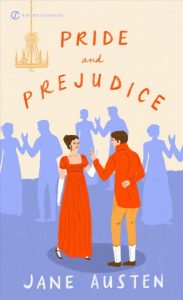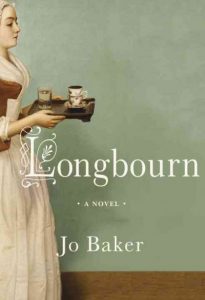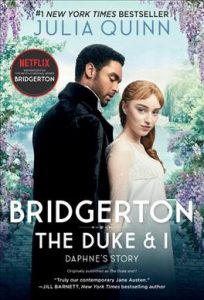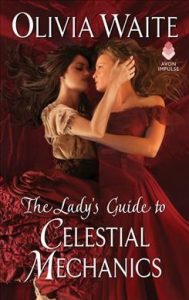One of the true bummers about the fabric of reality and the nature of spacetime is that time travel isn’t possible. But humanity’s urge to experience the past and foresee the future is a strong one, and since when have we ever let something like scientific impossibility or astronomical odds stop us? Necessity is, after all, the mother of invention. In lieu of a literal time machine, humans, clever creatures that we are, invent, recreate and reimagine history while also crafting and projecting the future through storytelling.
In this blog series, we’ll travel through time in the fictional dimension. Each post will recommend works of fiction set in a specific historical (or future) time and/or place. Explore different perspectives of the past and forecasts of the future in Stacks to the Future.
Today’s Destination: Regency England
The Regency Period began in 1811, the year that the Prince of Wales assumed the role of Prince Regent when the deteriorating mental health of his father, George III, prevented him from ruling over Great Britain and its colonies. If George III sounds familiar, that’s because he’s the king the colonists were fighting against in the American Revolutionary War.
The Regency Period lasted until the death of George III in 1820, when the Prince Regent began his reign as George IV. The era is perhaps now most famous for two things: the end of the Napoleonic Wars and Jane Austen.
The early years of the Regency Period saw the final defeat of Napoleon Bonaparte at Waterloo. After decades of tension and warfare between England and France, things were finally settling down to their usual dynamic of mutual open disdain.
Our cultural memory of the Regency Era has perhaps been best defined by Jane Austen (1775–1817), a novelist who is probably best known for Pride and Prejudice. Austen told stories of strong-willed women, clashes between social classes, the consequences of unchecked privilege, ballroom gossip and of course love. It is in large part because of Austen’s novels —all of which were published during the Regency Era—that we remember it as an era of manners, ball gowns, propriety and tea time. She is even said to have invented the modern romantic comedy.
You can find these titles either in person in our library stacks or in our digital collection. Title descriptions are provided by the publisher.

The OG
Pride and Prejudice by Jane Austen
Spirited Elizabeth Bennet is one of a family of five daughters, and with no male heir, the Bennet estate must someday pass to their priggish cousin William Collins. Therefore, the girls must marry well—and thus is launched the story of Elizabeth and the arrogant bachelor Mr. Darcy, in a novel renowned as the epitome of romance and wit. Pride and Prejudice is Jane Austen’s masterwork, an entertaining portrait of matrimonial rites and rivalries, timeless in its hilarity and its honesty.
Why it’s great: Pride and Prejudice is the quintessential Regency-era romance. A literary classic, it deftly challenges the dynamics of class and gender during Austen’s time. Elizabeth Bennet is a wry, compelling, flawed heroine who faces the expectations and hypocrisies of her society with humor and not a little stubbornness.
Want to watch it instead? Find the 2005 adaptation staring Keira Knightley as Elizabeth Bennet in our movie collection on the 2nd floor. The 1995 television series starring Colin Firth as Mr. Darcy can be requested through our catalog.
FIND IT NOW

Below the Ballroom
Longbourn by Jo Baker
The servants at Longbourn estate, only glancingly mentioned in Jane Austen’s classic, take center stage in Jo Baker’s lively, cunning new novel. Here are the Bennets as we have never known them: seen through the eyes of those scrubbing the floors, cooking the meals and emptying the chamber pots. Our heroine is Sarah, an orphaned housemaid beginning to chafe against the boundaries of her class. When the militia marches into town, a new footman arrives under mysterious circumstances, and Sarah finds herself the object of the attentions of an ambitious young former slave working at neighboring Netherfield Hall, the carefully choreographed world downstairs at Longbourn threatens to be completely, perhaps irrevocably, upended. From the stern but soft-hearted housekeeper to the starry-eyed kitchen maid, these new characters come vividly to life in this already beloved world.
Why it’s great: Most stories about the Regency Period focus on the rich and affluent. Baker’s novel, however, focuses on the servant class, where privilege is practically nonexistent and happily ever after looks quite different from the likes of Elizabeth Bennet and Mr. Darcy. It’s a refreshing and illuminating take on a classic novel from a perspective that is often—usually purposefully—ignored.
FIND IT NOW

A Romantic Fantasy
The Duke and I by Julia Quinn
The rakish Duke of Hastings will stop at nothing to hold the marriage-mongers and matchmakers of his town at bay, even if it means pretending to be engaged to the lovely Daphne Bridgerton, but strong feelings soon intervene on both sides of this convenient arrangement.
Why it’s great: Julia Quinn’s Bridgerton series is a fun, often steamy series that reimagines romantic entanglements of the upper classes during the Regency Period. With heroines who have decidedly modern-leaning opinions about love and marriage and brooding heroes with secrets and hidden passions, Quinn’s Bridgerton novels offer an undeniably fun romp. This is the first in the series.
Want to watch it instead? Check out a Roku from our library’s collection in order to access the Netflix Bridgerton series, inspired by Quinn’s novels. The series reimagines the Regency Period as a sort of fantasy world of racial harmony. It is an inaccurate picture of the era that willfully ignores the racial politics of an imperial nation that had not yet even outlawed slavery. Nonetheless, the (somewhat) multicultural and diverse casting makes for compelling and inclusive storytelling that allows us to imagine the ideals we aspire to now in the past.
FIND IT NOW

Love Between Ladies
A Lady’s Guide to Celestial Mechanics by Olivia Waite
As Lucy Muchelney watches her ex-lover’s sham of a wedding, she wishes herself anywhere else. It isn’t until she finds a letter from the Countess of Moth, looking for someone to translate a groundbreaking French astronomy text, that she knows where to go. Showing up at the Countess’ London home, she hoped to find a challenge, not a woman who takes her breath away. Catherine St Day looks forward to a quiet widowhood once her late husband’s scientific legacy is fulfilled. She expected to hand off the translation and wash her hands of the project. Instead, she is intrigued by the young woman who turns up at her door, begging to be allowed to do the work, and she agrees to let Lucy stay. But as Catherine finds herself longing for Lucy, everything she believes about herself and her life is tested. While Lucy spends her days interpreting the complicated French text, she spends her nights falling in love with the alluring Catherine. But sabotage and old wounds threaten to sever the threads that bind them. Can Lucy and Catherine find the strength to stay together or are they doomed to be star-crossed lovers?
Why it’s great: Much of the fiction that takes place in the Regency Period is extremely heteronormative. The first in the Feminine Pursuits series, A Lady’s Guide to Feminine Pursuits offers a steamy lesbian narrative that challenges the heterosexual monopoly on the Regency romance genre while developing compelling characters and story.
Looking for more 19th-century lesbian content? Try Gentlemen Jack, a television series based on the real life of Anne Lister, a landowner and business woman from Yorkshire, England in the 1830s.
FIND IT NOW

Exploring Historical Diversity
Sanditon, Season 1
Tom Parker is obsessed with turning the sleepy seaside village of Sanditon into a fashionable health resort. He enlists the backing of local bigwig Lady Denham. Through a mishap, Tom makes the acquaintance of the Heywoods and invites their eldest daughter, Charlotte, for an extended stay at Sanditon. Meanwhile, Lady Denham, a widow, is playing matchmaker for her destitute nephew, Sir Edward, who is determined to seduce Lady Denham’s ward, Clara.
Why it’s great: This adaptation of Jane Austen’s final and unfinished novel brings to life a vision of the Regency Period that illuminates the era’s colonial and racial complexities. One of the series’ main characters is Miss Lambe, an heiress from the Caribbean island of Antigua. The series casts Crystal Clarke, a Black woman, in the role, providing some much needed visibility of the historical reality of people of color in Regency England.
Want to read it instead? Jane Austen died before finishing Sanditon, but you can read the fragment by requesting Sanditon and Other Stories from our catalog.
FIND IT NOW
Explore the Era Through Nonfiction
For more information on the Regency Period, check out The Regency Years : During which Jane Austen Writes, Napoleon Fights, Byron Makes Love, and Britain Becomes Modern by Robert Morrison
For more information on The Battle of Waterloo, check out Waterloo: the history of four days, three armies, and three battles by Bernard Cornwell
For more information on Jane Austen and her life, check out Jane Austen at Home: a Biography by Lucy Worsley
And finally, for more information on the real-life bad girls of the Regency Period, check out Bad and Mad: Real Heroines of Regency, by Bea Koch
